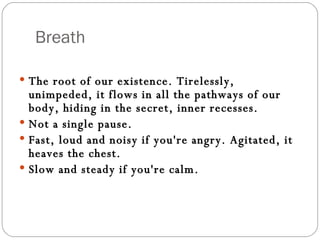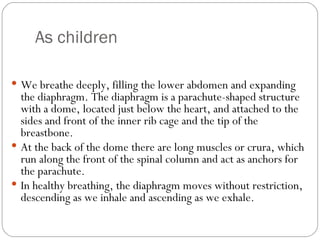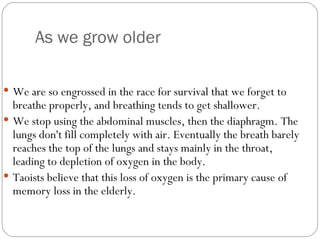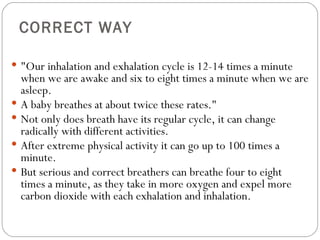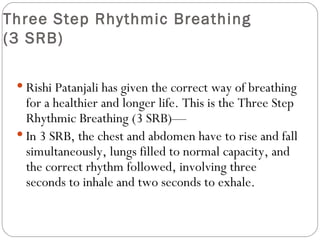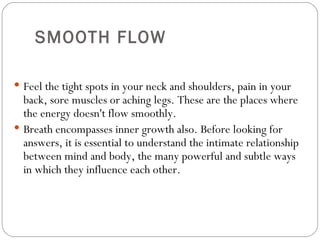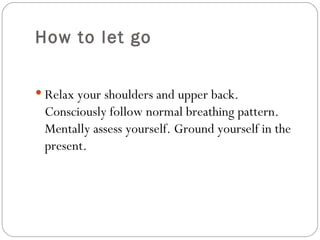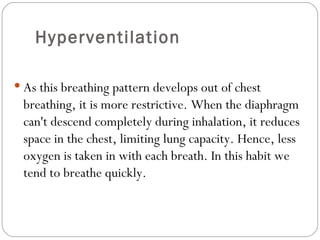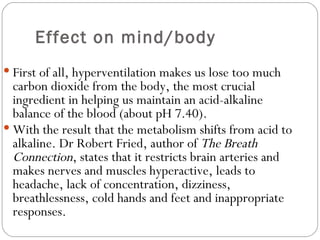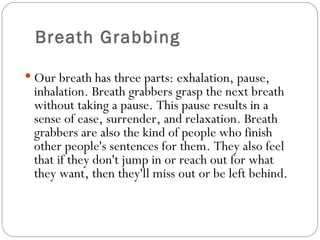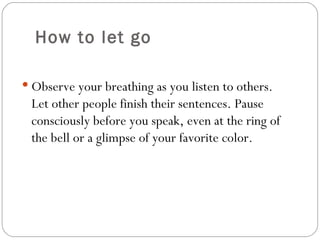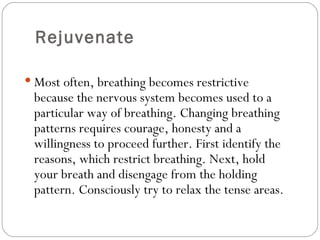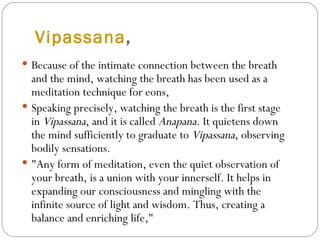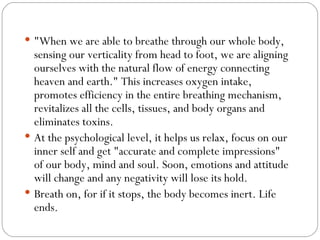Breath Teachings Of The Breath
- 1. The first of a series of articles on the meditation techniques contained in the ancient tantr highlights breath as a path to our real nature Breath - Teachings of the Breath
- 2. Breathing is synonymous with life. Yet, for most of us, it is just one more of those things that we take for granted. After all, it is just about inhaling oxygen and exhaling carbondioxide, right? Wrong. And it's high time we realized that.
- 3. With breath begins our journey of life. But as we breathe incessantly, taking it for granted, we develop bad breathing habits. Here are some tips on how to correct them for total well-being
- 4. Breath The root of our existence. Tirelessly, unimpeded, it flows in all the pathways of our body, hiding in the secret, inner recesses. Not a single pause. Fast, loud and noisy if you're angry. Agitated, it heaves the chest. Slow and steady if you're calm.
- 5. As children We breathe deeply, filling the lower abdomen and expanding the diaphragm. The diaphragm is a parachute-shaped structure with a dome, located just below the heart, and attached to the sides and front of the inner rib cage and the tip of the breastbone. At the back of the dome there are long muscles or crura, which run along the front of the spinal column and act as anchors for the parachute. In healthy breathing, the diaphragm moves without restriction, descending as we inhale and ascending as we exhale.
- 6. As we grow older We are so engrossed in the race for survival that we forget to breathe properly, and breathing tends to get shallower. We stop using the abdominal muscles, then the diaphragm. The lungs don't fill completely with air. Eventually the breath barely reaches the top of the lungs and stays mainly in the throat, leading to depletion of oxygen in the body. Taoists believe that this loss of oxygen is the primary cause of memory loss in the elderly.
- 7. CORRECT WAY "Our inhalation and exhalation cycle is 12-14 times a minute when we are awake and six to eight times a minute when we are asleep. A baby breathes at about twice these rates." Not only does breath have its regular cycle, it can change radically with different activities. After extreme physical activity it can go up to 100 times a minute. But serious and correct breathers can breathe four to eight times a minute, as they take in more oxygen and expel more carbon dioxide with each exhalation and inhalation.
- 8. Three Step Rhythmic Breathing (3 SRB) Rishi Patanjali has given the correct way of breathing for a healthier and longer life. This is the Three Step Rhythmic Breathing (3 SRB)— In 3 SRB, the chest and abdomen have to rise and fall simultaneously, lungs filled to normal capacity, and the correct rhythm followed, involving three seconds to inhale and two seconds to exhale.
- 9. TECHNIQUE • While breathing, both your chest and abdomen should rise and fall simultaneously. • The chest will require more air because of the space created by the rib cage. • The abdomen should not be blown up unnaturally during inhalation. • To figure out if you are breathing correctly, get a friend to observe you or lie down before a mirror with two heavy books, one on the chest and the other on the abdomen. • Check if both move together. • Our habit of breathing from the lower part of the chest results in shallow breathing, depriving the body of much needed oxygen.
- 10. SMOOTH FLOW Feel the tight spots in your neck and shoulders, pain in your back, sore muscles or aching legs. These are the places where the energy doesn't flow smoothly. Breath encompasses inner growth also. Before looking for answers, it is essential to understand the intimate relationship between mind and body, the many powerful and subtle ways in which they influence each other.
- 11. All our physical and psychological responses are accompanied by a change in breathing. Surprised, and a gasp immediately follows. If you're stressed out, there will be a different breathing pattern. "Stress may be real or imagined. Just imagining a stressful event can reduce inhalation volume. When we are continuously exposed to stress, then the body just forgets to relax." Obviously, the breathing pattern changes.
- 12. pranayama (yogic breathing techniques) " Prana is the energy permeating the universe at all levels-physical, mental, intellectual, sexual, spiritual and cosmic energy. It is usually translated as breath. Thus pranayama is an art and has techniques to make the respiratory organs move and expand intentionally, rhythmically and intensively." In these techniques, there is a long, sustained flow of inhalation, exhalation and retention of breath. Thus, the flow of prana is regulated along with thoughts, desires and actions, which gives poise and tremendous will power to master oneself. " Pranayama strengthens and refines breathing. Most of us practice pranayama without addressing underlying breath-holding habits. Paradoxically, pranayama frequently suppresses deep-seated fears and insecurities."
- 13. Chest Breathing This is probably the most common breathing pattern in today's stress-filled society. Also known as paradoxical breathing, It is a natural reflex when we are suddenly startled or frightened. We gasp, pull the abdomen in and breathe high into the chest. The lift of the abdomen and pelvic floor prevents the diaphragm from descending completely as we inhale. Chest breathers restrict breath movement in the abdomen, forcing it higher up into the chest, while shoulders move up and down.
- 14. Effect on mind/body Chest breathers rely on weak upper body muscles. Thereby developing chronic tension in thoracic spine, shoulders and neck. Moreover, this tension is resistant to massage or any other relaxation therapy as it recapitulates the moment the person resumes chest breathing, which is an incredible 22,000 times a day! Since we can't breathe in fully, we can't breathe out fully also. So we resort to breathing more quickly to make up for lack of oxygen. Scarier still is the fact that it sets the stage for an even more serious breathing problem: hyperventilation. Chest breathers normally sit on the edge of their seats and exude anticipation in their entire bearing. They never seem to have enough time to do all the tasks they set out on and often experience a chronic, free-floating state of anxiety. Scientific evidence now points to the connection between chest breathing, heart disease and high blood pressure.
- 15. Identify it Place one hand on your abdomen and the other on your chest. Observe the movement of both. If both your shoulders and chest are rising, you are probably not a chest breather. A chest breather suppresses breath in the lower abdomen, forcing it to move higher up into the body.
- 16. How to let go Relax your shoulders and upper back. Consciously follow normal breathing pattern. Mentally assess yourself. Ground yourself in the present.
- 17. Hyperventilation As this breathing pattern develops out of chest breathing, it is more restrictive. When the diaphragm can't descend completely during inhalation, it reduces space in the chest, limiting lung capacity. Hence, less oxygen is taken in with each breath. In this habit we tend to breathe quickly.
- 18. Effect on mind/body First of all, hyperventilation makes us lose too much carbon dioxide from the body, the most crucial ingredient in helping us maintain an acid-alkaline balance of the blood (about pH 7.40). With the result that the metabolism shifts from acid to alkaline. Dr Robert Fried, author of The Breath Connection , states that it restricts brain arteries and makes nerves and muscles hyperactive, leads to headache, lack of concentration, dizziness, breathlessness, cold hands and feet and inappropriate responses.
- 19. Breath Grabbing Our breath has three parts: exhalation, pause, inhalation. Breath grabbers grasp the next breath without taking a pause. This pause results in a sense of ease, surrender, and relaxation. Breath grabbers are also the kind of people who finish other people's sentences for them. They also feel that if they don't jump in or reach out for what they want, then they'll miss out or be left behind.
- 20. How to let go Observe your breathing as you listen to others. Let other people finish their sentences. Pause consciously before you speak, even at the ring of the bell or a glimpse of your favorite color.
- 21. Rejuvenate Most often, breathing becomes restrictive because the nervous system becomes used to a particular way of breathing. Changing breathing patterns requires courage, honesty and a willingness to proceed further. First identify the reasons, which restrict breathing. Next, hold your breath and disengage from the holding pattern. Consciously try to relax the tense areas.
- 22. Vipassana , Because of the intimate connection between the breath and the mind, watching the breath has been used as a meditation technique for eons, Speaking precisely, watching the breath is the first stage in Vipassana , and it is called Anapana . It quietens down the mind sufficiently to graduate to Vipassana , observing bodily sensations. "Any form of meditation, even the quiet observation of your breath, is a union with your innerself. It helps in expanding our consciousness and mingling with the infinite source of light and wisdom. Thus, creating a balance and enriching life,"
- 23. "When we are able to breathe through our whole body, sensing our verticality from head to foot, we are aligning ourselves with the natural flow of energy connecting heaven and earth." This increases oxygen intake, promotes efficiency in the entire breathing mechanism, revitalizes all the cells, tissues, and body organs and eliminates toxins. At the psychological level, it helps us relax, focus on our inner self and get "accurate and complete impressions" of our body, mind and soul. Soon, emotions and attitude will change and any negativity will lose its hold. Breath on, for if it stops, the body becomes inert. Life ends.
- 24. Ěý




